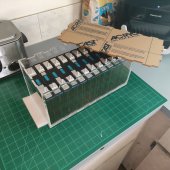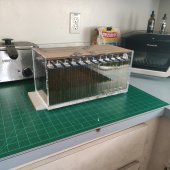MadMax03
New Member
- Joined
- Sep 21, 2019
- Messages
- 249
So a little update. Got the battery case and put it together. It's not finished, have yet to drill holes, mount terminals, etc., but you get the idea.
So thanks to you guys I realized the error in my ways. I should re-wire the cells in 4S3P, so that I only require one BMS, and thanks also to those that mentioned that there are high-amp BMS's. I have found this one:
So, now that we have BMS protection, am I correct in my integration into the car? I think I need to wire the B+ cable from the alternator to the BMS, and have the main vehicle power in the middle of those two, then wire the Positive out ot the BMS to the battery. This is in case the BMS shuts off charging to the battery, the car still runs on alternator. Does this sound correct? See diagram I drew (nevermind the balance lead placement, just there as a visual).
Edit: Starter cable to be wired directly to battery + terminal
So thanks to you guys I realized the error in my ways. I should re-wire the cells in 4S3P, so that I only require one BMS, and thanks also to those that mentioned that there are high-amp BMS's. I have found this one:
So, now that we have BMS protection, am I correct in my integration into the car? I think I need to wire the B+ cable from the alternator to the BMS, and have the main vehicle power in the middle of those two, then wire the Positive out ot the BMS to the battery. This is in case the BMS shuts off charging to the battery, the car still runs on alternator. Does this sound correct? See diagram I drew (nevermind the balance lead placement, just there as a visual).
Edit: Starter cable to be wired directly to battery + terminal





